Friday Morning
New York Botanical Garden
(Note: Clicking on any image in this travelogue will bring up a full screen version of the image.)
Friday morning: Gettin' there
Well, Friday was the right day to do the Botanical Garden. But it was the wrong day to try to get there, and Thursday night was an even worse time for Jenny to get to my place from hers in Vermont. The whole week had been rainy, culminating in a horrendous downpour with thunder and lightning on Thursday night. The storm probably hit its peak just as she was traversing the Tapan Zee Bridge (I refuse to call it the "Governor Mario M. Cuomo Bridge) across the Hudson river. I had warned her to bring her tall boots in anticipation of significant puddles along my driveway. She arrived around 10:00 to find my car up at the head of my 200 foot long driveway in anticipation of high water, leaving her only enough room to leave her car in front of mine. I had seen the river water coming up over the banks just before it got dark, and gone into flood-prep mode by moving my lawn mower up onto a table in the garage, picking up any tools that had been on the floor, and moving my car out.
Those of you familiar with me and my blog will know that my back yard borders on the Rockaway River. Except when my front yard borders on the Rockaway river. That will happen every 2 or 3 years, and is not the disaster it sounds like. When my property got flooded for the first time only 6 months after I bought the place in 1979, I resolved to do something about it. What I did was to raise the house 6-1/2 feet, providing me with a full under-house garage, and turning a potential disaster into a minor inconvenience. That procedure is worth a full Blog post all by itself, which I will write some day. You can see several posts about a couple of past floods by going to High Water, Ho-Hum, or Irene.
Friday Morning
Before we went to bed Thursday night, we had put my car all the way at the head of the drive way, and Jenny's car at the head of my next-door neighbor's lot, which is somewhat uphill from my property. Friday morning dawned bright and sunny, offering the above views of my back yard out the bedroom windows. Looks pretty scary, don't it? Actually, it's no problem. We had prepared for it. The water was deeper than I had anticipated, but not deeper than I had prepared for. I thought to be able to walk out in boots. I could have made it out in a bathing suit and water shoes, but Jenny hadn't brought anything like that. This was a flood for the canoe.
Getting Out of the House
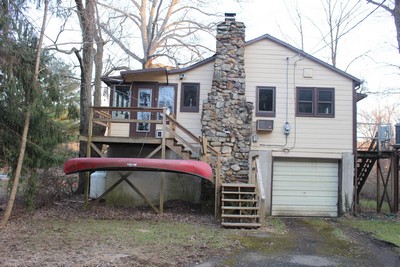 4. Canoe stowed on davits |
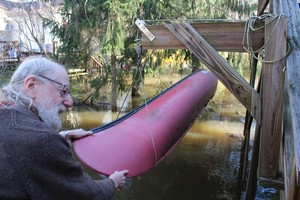 5. Rotating the canoe in its sling |
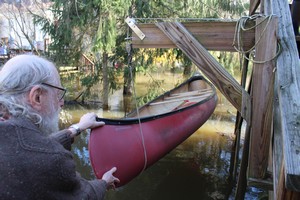 6. Canoe upright |
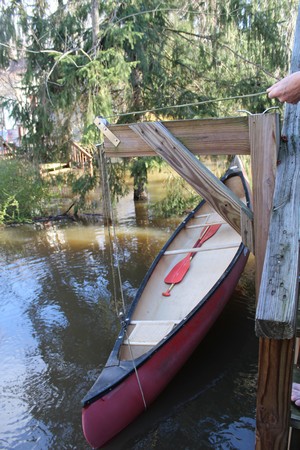 7. Lowering the stern |
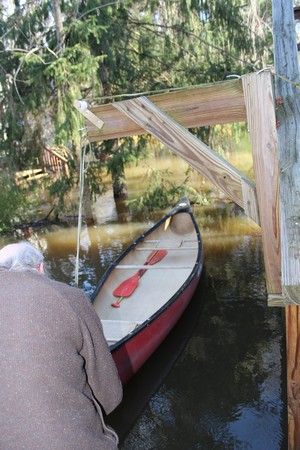 8. Canoe in the water |
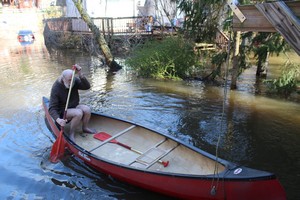 9. Me in the stern |
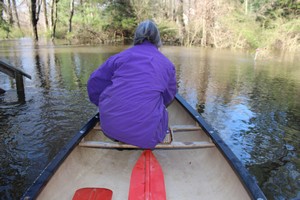 10. Jenny in the bow |
||
It's a rare flood that requires the use of the canoe. Maybe once every 5 - 10 years, or so. Indeed, I would not have resorted to the canoe for this one either if I had been by myself. The water was only a little above my knees at the deepest point (and just beginning to recede, as evidenced by the high water mark about an inch above the surface on the wall of the house.) But Jenny's knees are considerably lower than mine, and she hadn't packed suitable clothing and equipment. So we went paddling.
As I have reported in previous posts, I store my canoe suspended upside down on home-made davits attached to my deck (Photo 4). The inverted storage position keeps rainwater out of the boat. The davit ropes end in a sling that wraps around the whole canoe, and the canoe is free to rotate within the sling. That allows me to rotate the canoe upright (Photos 5 and 6). I then lower the bow and stern davit ropes one at a time to float the canoe in the water (Photos 7 and 8). The slings detach from the davit ropes with a little clevis (That's what I'm doing in photo 8.), and I can step into the canoe (carefully) from the steps down from the deck. The detached slings also serve as tow-ropes.
We beached the canoe at the end of the driveway. (Photo 11. Click the photo for a full-screen view, and note the makeshift sign affixed to it for the UPS truck to leave my expected packages in the canoe. The driver must have gotten a chuckle about that.) Photo 13 shows my next-door neighbor's 2nd car. It was not in running condition, so he couldn't move it out of the reach of the water. It's probably even less in running condition now.
New York Botanical Garden
 Our route |
 NYC Detail |
|
|
New York City has two magnificent Botanical Gardens, the New York Botanical Garden and the Brooklyn Botanical Garden. I would have preferred to do Brooklyn, because its vast cherry tree orchard was just coming into bloom. But the anticipated horrendous traffic we would have had to negotiate on the way back led us to choose the NYBG in the Bronx. We had started our departure around 10:00 AM, and so were actually on the road by 10:30. It wasn't a bad time to drive into New York City. Traffic was pretty manageable, even crossing the George Washington Bridge across the Hudson and traversing the notorious and ill-named Cross-Bronx Expressway for the few exits required. (Note the red coloration on the map routes above.) I grew up in New York City, and remember many trips as a kid to the Bronx Zoo adjoining the Botanical Garden, but I can't remember the family ever visiting the Garden. I've been there once or twice as an adult, but we all are aware how rarely we do any sightseeing locally except to show visitors around.
The Grounds
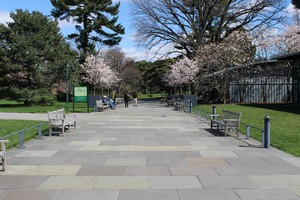 14. View from Visitor's Center |
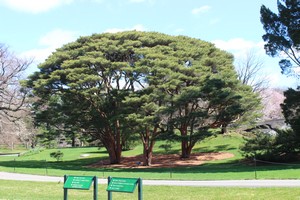 15. Perfect tree |
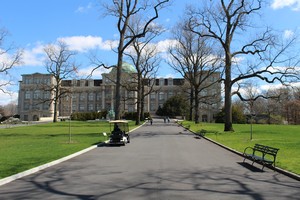 16. Administration Building |
|
According to Wikipedia:
The New York Botanical Garden (NYBG) is a botanical garden at Bronx Park in the Bronx, New York City. Established in 1891, it is located on a 250-acre (100 ha) site that contains a landscape with over one million living plants; the Enid A. Haupt Conservatory, a greenhouse containing several habitats; and the LuEsther T. Mertz Library, which contains one of the world's largest collections of botany-related texts. As of 2016, over a million people visit the New York Botanical Garden annually. .
It's a pretty pricey attraction: $28 ticket (for seniors), and $20 parking fee. But you get what you pay for. The Garden is magnificent, and the parking is off the streets of the Bronx. We arrived around 11:00. While the parking lot was relatively full, and any NYC residents probably arrived by public transport, the Garden itself is so big that it seemed rather sparsely populated. (Photo 14) The lawns, and some of the trees appeared to have been trimmed with cuticle scissors. What looked to be an administration building (Photo 16) appeared a pretty spiffy place to work. It was still pretty early in the season. The cherry trees (Photos 17 & 18) were in bloom, but whatever kind of tree is depicted in Photo 19 wasn't, although it was surrounded by a bunch of pretty purple wildflowers.
Please note: I am no botanist or gardener. If you find any unidentified or misidentified flora in this travelogue, I will welcome any corrections.
Rock Garden
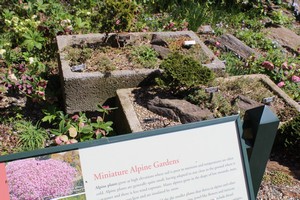 20. Miniature Alpine garden |
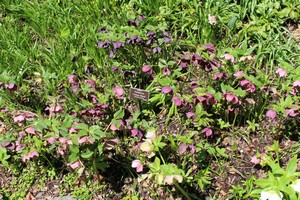 21. Hellebore ("Almost black") |
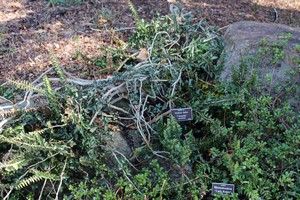 22. English Ivy |
We walked through a rock garden that features flowers that thrive in rocky soil. The hellebore (Photo 21) reminded me of the wildflowers we saw on the alpine trail at the top of the cable car in Whistler, BC during our Canadian Rockies rail tour in 2012, if not because of the particular species, but the general environment in which they grew. I was able to identify the daffodils in photo 24 without benefit of the missing label, and their presence in this rock garden indicates that they will thrive just about anywhere. The pond and cascade (Photos 23 and 25) are the first links of an elaborate artificial recirculating water system that winds through many different areas of the Garden. In 1932, by a laborious process, rocks and boulders were collected from all over the grounds, and carried to their final destinations by horse-drawn carts.
Seen along the way
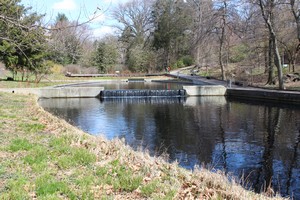 26. Water Feature |
||
Here are a number of random things that caught my eye as we rambled. Photo 26 shows the Water Feature at the end of the recirculating system referenced in Photos 23 and 25. And Photo 27 is the accompanying placard that explains the elaborate system that filters and cleans that system. (Click the photo to get a more readable full-screen image. If you're viewing this travelogue on a phone...sorry. Read it on you computer when you get home.) Photo 28 is just some sort of tree with lovely camo pattern bark. Photo 29 shows where the earth was scraped down to bedrock by glaciers that would have topped the Chrysler Building by 100 feet, whose weight on the gravel beneath them left tracks in the bedrock. And Photo 30 is a placard explaining the glacial action. And Photo 31 is a tiny bud just emerging on some flowering tree, and Photo 32 shows my finger against the bud (slightly out of focus) to give you the scale.
Bridge Trail
We took the eponymous Bridge Trail (Photo 33) across the park eastward to the item for which it was named (Photo 34). This is a most elegant stone arch bridge, which I suspect to be a fraud. The bridge is way too slender, and the arch too shallow for it to be a true arch bridge supported by the stones in compression. I will wager my Engineering License that the stones are merely a cladding over a steel framework that is the true load-bearing structure. (By the way, I've never had an official State Engineering License. But I'd bet it if I had one.) The bridge crosses the Bronx River (Photo 35), which is mostly a placid, and somewhat polluted minor tributary about the size of the Rockaway River behind my house. But in places, it narrows and steepens, making for some entertaining rapids, and even a little waterfall a couple of hundred yards upstream of the bridge.
More sights along the way
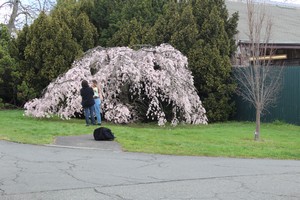 36. Weeping cherry tree |
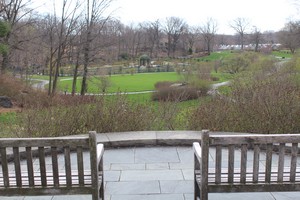 37. Vista |
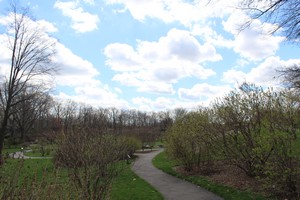 38. Clouds |
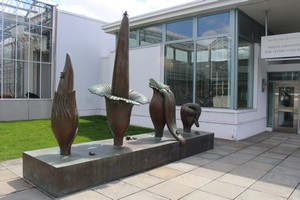 41. Sculpture |
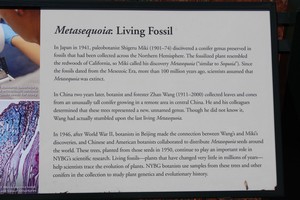 43. Metasequoia placard |
We wandered onwards. The photos above are of various attractions that caught my eye.
Photo 36: Weeping Cherry Tree. Jenny thinks it may be a Japanese variety..
Photo 37: A couple of park benches artistically situated to overlook a lovely vista.
Photo 38: I knew that a photo wouldn't do this scene justice, and I was right. I was taken by the spectacle of fluffy clouds sweeping across the sky, and just had to snap the picture.
Photo 39: The gardener's art.
Photo 40: A bazillion daffodils in front. Behind, the Nolan Greenhouses, not open to the public, but where the staff prepared plantings to be transplanted onto the grounds when ready.
Photo 41: An intriguing sculpture in front of the Nolan Greenhouses.
Photo 42: Metasequoias, ancient predecessors to American the sequoia tree, originally found only as fossils, and thought to be extinct, but later discovered still living in China. Grown from seedlings at the Botanical Garden. Read the history in Photo 43.
Further meanderings
We wandered onwards in the southeast corner of the grounds. The photos above are of various attractions that caught my eye.
Photo 44 depicts one of a pair of what I would call gazebos, or perhaps trellises, but without their attendant vines.
Photo 45: I dunno what that is, but it sure is purty.
Photo 46: The color combination isn't what you'd call subtle. But flowers needn't be subtle.
Photo 47: Aptly named Snake-Branch Spruce
Photos 48 - 50: The placard proclaims, "A million daffodils". Braggart! There are only 150,000.
Photo 51: Look at the full-screen version of that one and dig the swirly striations. Looks like it got spat out of a volcano and solidified.
Photos 52 - 53: The Lorillard Snuff Mill now known as the Lillian and Amy Goldman Stone Mill, is the oldest existing tobacco manufacturing building in the United States. It was built around 1840 next to the Bronx River to supplement an earlier building of the same function. The schist that makes up its walls was quarried locally. The mill wheel is gone now. It's not open to the general public, but rather rented out for posh weddings and other private functions. (I neglected to take my own picture, so I nicked Photo 52 from Google Images. So there's no high-res version available.) They were preparing the site for a wedding that afternoon, setting up chairs and polishing windows and the like. The outdoor area for the service behind the building shown in Photo 53 looked very classy. But they would have to crank up the sound system to make the service heard over the roar of the rushing Bronx River behind the podium. (Things one must think about when choosing a wedding site.)
Discovery Center
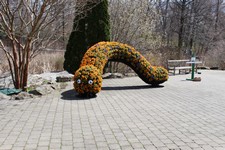 54. Floral caterpillar |
 55. Caterpillar with companion |
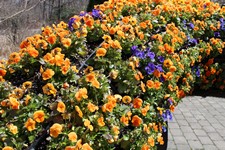 56. Caterpillar framework |
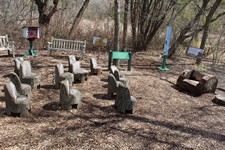 57. Children's classroom |
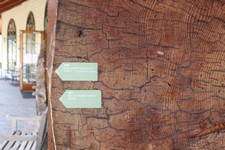 61. Later still (Maybe) |
I would have called it the "Children's Garden". The NYBG uses the more politically correct, and probably more accurate term, Discovery Center. Photos 54 and 55 depict a couple of charming floral sculptures on the apron outside the building, and Photo 56 is a closer view, showing the steel mesh framework that gives them their shape. And I love the clever (if not particularly comfortable) construction of the chairs in the outdoor classroom where children are instructed. Photos 58 through 61 give a striking image of the size and age of the sequoia from which the wheel was cut. The markers point to specific rings, giving the year in which they were formed, and botanical discoveries or events that happened in that year. You'll have to look at the full-screen versions on a decent computer monitor to be able to read them. Photo 59 indicates the tree sprouted in 1665. As best I can count rings outward from the outermost marker in Photo 60 (1912), the tree was cut down around 1930, giving its age of 265. There's a puzzling discrepancy I spotted only now when composing this blog post. The outermost ring shown in Photo 60 is labeled 1912. However, the outermost ring in Photo 61 is labeled 1906, and yet is much closer to the edge than the 1912 label in Photo 60.
By this time, I was getting hungry, and a bit footsore, so we headed back to the visitor's center for some lunch.
Orchid Show
We spent the afternoon at the Enid A. Haupt Conservatory, viewing the Garden's extensive and spectacular orchid collection. This was completed in 1899, and looks like it was disassembled from the Crystal Palace in London that housed the Great Exposition, and reassembled here. I know nothing about orchids, save what I learned by reading Nero Wolfe novels. So most of the photos are of plants that caught my eye, and looked pretty. Consequently many of the photos are without caption. They are arranged roughly in the order we encountered them. Here is some commentary on some of the images:
Photos 62, 63, and 62: Exterior views of the Conservatory. Very elegant.
Photo 67: A somewhat out-of-place modern sculpture right in the entrance foyer (lobby? What would one call it?) of this 19th Century structure.
Photo 71: This was a real strange one. It looks like it tipped over, but it actually grows this way. Orchids are, after all, parasites that take root on other plants, and this one seems to spring from the bottom of whatever it roots on.
Photos 76 & 77: If these orchids were people, they'd be women in the Easter Parade wearing all their finery and jewelry.
Photo 79: This passageway between two buildings reminds me of the tunnel under the runway at Ohare Airport that connects two terminals. The colored lights gradually fade on and off, and between colors. Rather than being garish as it appears from the still photo, it actually evokes a rather soothing and placid atmosphere. I don't remember if there was piped-in mood music, but it seems there should have been.
Photos 81 - 84: Yes, cacti. I wouldn't have thought orchids to grow in desert conditions, but evidently they do. There was an entire room of desert orchids (Photo 78).
Photo 90: I liked this one. The spiral in the foreground is a newly emerged leaf that has yet to unfurl and start collecting sunlight.
We spent about 2 hours walking through the exhibit. Just looking at the grid of photos reminded me of what if felt like to be in that building. The eyes are assaulted by brilliant splashes of color from all directions. It gets a little dizzying. There was not much scent in the air, though. I seem to remember reading somewhere that orchids don't smell. It was somewhat overwhelming.
After a complete, but superficial tour through the whole exhibit, we were both pretty pooped. And if we were going to catch that Tom Paxton concert back in New Jersey, we figured we were both ready to hit the road back home. We knew we would be hitting the beginning of Friday night rush hour traffic even with a 3:30 departure, and we did. It was pretty much bumper-to-bumper all the way along the Cross Bronx Expressway and the George Washington Bridge. And there were slow spots along I-80 too. We took it in good spirits and companionable conversation, and got home in time to feed the cat and take a quickie nap before heading out to the Troubadour for the concert.
Tom Paxton and the DonJuans put on a great show. They started with a Q&A session, and continued with two wonderful sets of old favorites and newly written songs. He even mentioned me from the stage, which gave me a great thrill. At age 84 he's still singing strongly, and still writing up to his old standards. It was a wonderful day, and a wonderful night. Up at 6:30 so that Jenny could get on the road in time for her rehearsal in Amherst.
And it was over.